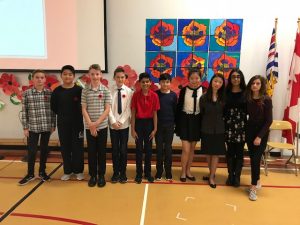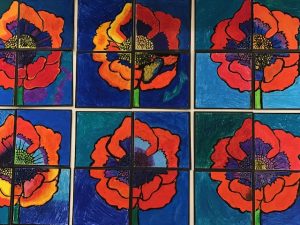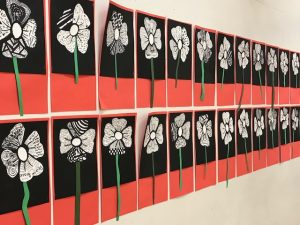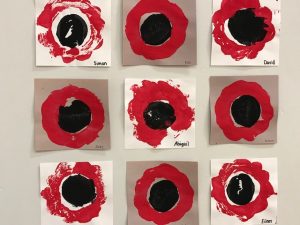How to Explain Remembrance Day to Kids
November 18, 2018 - 4 minutes read“The greatest glory of a free-born people is to transmit that freedom to their children.” William Havard
Each year, Ridgeview students are escorted into the gymnasium to take part in and/or present at the Remembrance Day ceremony. Prior to the ceremony, teachers read and discuss with students an assortment of literature to help build their understanding of the significance of Remembrance Day.
Books including In Flanders Fields, the story of the Poem by John McCrae, The Peace Book by Todd Parr, A Poppy Is to Remember by Heather Patterson, What does Peace Feel Like? By Vladimir Radunsky, At Vimy Ridge: Canada’s Greatest world War 1 Victory by Hugh Brewster, provide historical relevance and deliver positive and hopeful messages of peace.
Students extend their learning by creating messages and images of peace, and researching history including political and social foundations and worldwide observances that make this day special and noteworthy. Voices in the Wind a poem written by grade 6 Ridgeview student Julia sensitively captures her understanding of Remembrance. Artwork by students across the grades also capture symbolism and emotions of this day.
Today’s Parent writer contributor Jennifer Pinarski asked other parents on social media how they extended messages learned in school and how they talk with their young children about Remembrance Day. Following are a few responses received:
“My children know of an uncle who landed on beaches of Normandy at 17 and whose best friend was killed. We talk about Remembrance Day with complete candour, teaching history and respect. We also attend Remembrance Day ceremonies each year. I don’t worry that they don’t understand, because they will understand what they can. Each year they’ll understand it more.” – @LorraineJLola via Twitter
“I stay away from ‘fight’ and ‘war’ and stick to honouring people who helped keep us safe and made Canada what it is today.” – @SachaCoutu via Twitter
“There was a few four-year-old children in my daycare who asked me why I had a poppy on my coat. I told them it was because I love Canada and I’m so thankful that it’s a safe place to live.” – Lea via Facebook
The Ridgeview Remembrance Day ceremony is my favourite assembly of the year. The ceremony is one where students enter the gym quietly, wear their precious poppies over their heart and prepare to listen to Remembrance messages. Entirely student led, student presenters welcome guests, explain the importance of remembering, outline Canada’s role in war and peace, explain the significance of the poppy, and recite the In Flanders Field Story. Most touching are the presentations by grades 2, 3, and 4 students who recite a poem and sing heartfelt musical numbers including In Flanders Fields and Blowing in the Wind. Complete silence in the gymnasium of over 400 including students, guests and staff followed as Ridgeview’s music director Mrs. Soderling played the last post and reveille, and students, guests, and staff observed a minute of silence.
When speaking to children about the significance of Remembrance Day there is no need to expound upon the atrocities of war. We can best honour this day by teaching kids about both the honour and courage of those who sacrificed their lives in an effort to preserve the freedoms that we all enjoy. In the end, Remembrance Day can provide an excellent time to instil your children with an understanding of the implications of war and give them a reason to work towards a more peaceful world.




Recent Comments